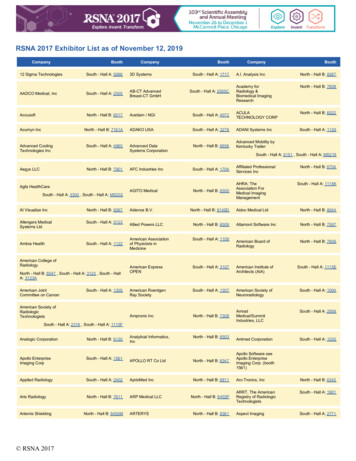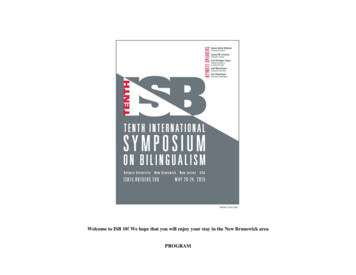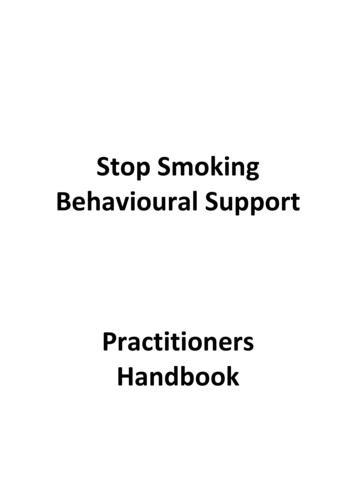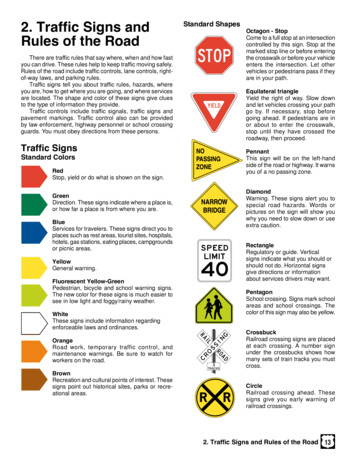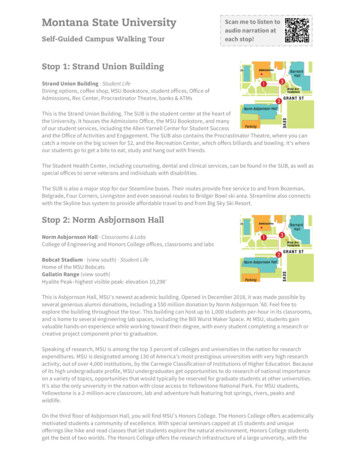
Transcription
Montana State UniversitySelf-Guided Campus Walking TourScan me to listen toaudio narration ateach stop!Stop 1: Strand Union BuildingStrand Union Building · Student LifeDining options, coffee shop, MSU Bookstore, student offices, Office ofAdmissions, Rec Center, Procrastinator Theatre, banks & ATMsThis is the Strand Union Building. The SUB is the student center at the heart ofthe University. It houses the Admissions Office, the MSU Bookstore, and manyof our student services, including the Allen Yarnell Center for Student Successand the Office of Activities and Engagement. The SUB also contains the Procrastinator Theatre, where you cancatch a movie on the big screen for 2, and the Recreation Center, which offers billiards and bowling. It’s whereour students go to get a bite to eat, study and hang out with friends.The Student Health Center, including counseling, dental and clinical services, can be found in the SUB, as well asspecial offices to serve veterans and individuals with disabilities.The SUB is also a major stop for our Steamline buses. Their routes provide free service to and from Bozeman,Belgrade, Four Corners, Livingston and even seasonal routes to Bridger Bowl ski area. Streamline also connectswith the Skyline bus system to provide affordable travel to and from Big Sky Ski Resort.Stop 2: Norm Asbjornson HallNorm Asbjornson Hall · Classrooms & LabsCollege of Engineering and Honors College offices, classrooms and labsBobcat Stadium · (view south) · Student LifeHome of the MSU BobcatsGallatin Range (view south)Hyalite Peak–highest visible peak: elevation 10,298’This is Asbjornson Hall, MSU’s newest academic building. Opened in December 2018, it was made possible byseveral generous alumni donations, including a 50 million donation by Norm Asbjornson ’60. Feel free toexplore the building throughout the tour. This building can host up to 1,000 students per-hour in its classrooms,and is home to several engineering lab spaces, including the Bill Wurst Maker Space. At MSU, students gainvaluable hands-on experience while working toward their degree, with every student completing a research orcreative project component prior to graduation.Speaking of research, MSU is among the top 3 percent of colleges and universities in the nation for researchexpenditures. MSU is designated among 130 of America’s most prestigious universities with very high researchactivity, out of over 4,000 institutions, by the Carnegie Classification of Institutions of Higher Education. Becauseof its high undergraduate profile, MSU undergraduates get opportunities to do research of national importanceon a variety of topics, opportunities that would typically be reserved for graduate students at other universities.It’s also the only university in the nation with close access to Yellowstone National Park. For MSU students,Yellowstone is a 2-million-acre classroom, lab and adventure hub featuring hot springs, rivers, peaks andwildlife.On the third floor of Asbjornson Hall, you will find MSU’s Honors College. The Honors College offers academicallymotivated students a community of excellence. With special seminars capped at 15 students and uniqueofferings like hike and read classes that let students explore the natural environment, Honors College studentsget the best of two worlds. The Honors College offers the research infrastructure of a large university, with the
individual attention of a small, liberal arts college. Plus, the Honors College plays an integral role in helpingexcellent students win prestigious national awards, such as Goldwater and Truman Scholarships.Stop 3: Barnard HallBarnard Hall · Classrooms & LabsEngineering and science classrooms, research labsThis is Barnard Hall. Barnard is home to the Department of Physics, theGianforte School of Computing, as well as the Physics Learning Center. It’s alsohome to various research labs, including the Center for Biofilm Engineering,Microfabrication Lab and the Robotics Lab.Discoveries from MSU’s Center for Biofilm Engineering, or CBE, have contributed to technologies that preventamputations from chronic wounds, protect groundwater from pollution and develop better disinfectants. Morethan 730 undergraduates from a variety of disciplines study and work in CBE laboratories every year.Stop 4: East CampusRoberts Hall · (view southeast) · Classrooms & LabsCollege of Engineering classrooms and officesCobleigh Hall · (view southeast) · Classrooms & LabsCollege of Engineering classrooms and officesHannon Hall · (view northeast) · Residence HallWomen’s residence hallAmerican Indian Hall (under construction) · ( view northeast )Classrooms & student support servicesHapner Hall · (out of view) · Residence HallWomen’s residence hall (5 minute walk north)The Quads · (out of view) · Residence HallHonors College residence hall (5 minute walk north)You are currently located at the east entrance to the Centennial Mall. The Centennial pedestrian mall wascreated in 1993 to celebrate MSU’s 100th birthday. From here, you can see several important locations on ourcampus.First is Roberts Hall, the home of the Mechanical, Industrial and Financial Engineering programs. About 90% ofMSU Engineering students pass the Fundamentals of Engineering Exam, about 10% higher than the nationalaverage. Engineering graduates report the highest job placement rates among MSU graduates at the highestaverage starting salaries.Across the street to the east, you can see one fraternity and one sorority house. The fraternity and sorority lifeprogram at MSU is made up of 7 fraternities and 5 sororities where students can find a community that fits them,easing the transition into college life. Recruitment takes place at the beginning of each semester, with about 5%of MSU students joining a fraternity or sorority.Next, you can see a tepee sculpture, designed by alumnus Jim Dolan. This sculpture marks the position of MSU’snew American Indian Hall, slated to open in 2021. This 20 million donor-funded building will offer classroomand academic collaboration spaces, a cultural activities center, and space for an expanded Native AmericanStudent Success center.
Beyond this sculpture, you can see Hannon Hall, one of several residence halls located on the MSU campus.Additional residence halls will be covered throughout the tour.Stop 5: Wilson & Hamilton HallsWilson Hall · (view north) · ClassroomsCollege of Letters and Science classrooms and officesHamilton Hall · (view southeast) · ClassroomsGallatin College MSU classrooms and officesMoving toward the center of campus, you can find several academic-centricbuildings and centers for students.Hamilton Hall was built in 1910 as the first Women’s residence hall on campus. Today it houses Gallatin College,which offers certificate programs and associate’s degrees. On the third and fourth floors are MSU’s Army and AirForce ROTC programs, which provide leadership training and scholarship opportunities to students interested inofficer training for the military. MSU has the only Air Force ROTC in Montana.Next door, you will find Wilson Hall, home of the College of Letters and Science, MSU’s largest academic college.It also contains the Math Learning Center and the Writing Center, where students get help mastering math andwriting. You might notice Wilson Hall’s unusual, horseshoe shape. That’s because students wanted to save thegrove of trees growing in the center. Inside, you will find a statue of Walt Whitman, seated on a bench in thecourtyard.Stop 6: Alumni PlazaJabs Hall · ClassroomsCollege of Business classrooms and offices, Sola CaféRendezvous Dining Pavilion · (view northwest) · DiningDining, lounges, coffee shopLangford Hall · (view northwest) · Residence HallMen’s residence hallThis is Alumni Plaza, and in the center of Alumni Plaza is Spirit, the bronze bobcat who proudly appears in manystudents’ and visitors’ photos. It’s tradition for students to take a picture with Spirit when they first come toMSU, and again on their graduation day.The bobcat was chosen as MSU’s mascot for its cunning intelligence, athletic prowess and independent spirit.Depending on the time of year, Spirit might be dressed up to celebrate homecoming or the holidays.Next to Alumni Plaza you will find Jabs Hall, one of MSU’s newer academic buildings. It is the home to the JakeJabs College of Business and Entrepreneurship, one of the fastest-growing colleges at the university. Thecollege is accredited by the Association to Advance Collegiate Schools of Business. Only 5% of elite businessprograms worldwide have achieved this accreditation. Feel free to explore the inside of Jabs Hall while locatedat this stop.Business courses are held in this new, LEED Gold certified, collaborative learning space. Featuring 2 fireplaces,local food options, and daylight views in more than 90% of regularly occupied spaces, Jabs Hall was designed toinspire collaboration and innovation, all while operating efficiently to save energy.
This is one of many gathering spaces in the building, where students from all over campus interact withprofessors and each other. Student organizations, such as the LaunchCats entrepreneurship club, help realbusinesses in the Bozeman area grow, as well as give students the tools they need to create their own start-ups.Past Jabs, you will find Rendezvous Dining Pavilion. This new, 18 million 800 seat dining complex opened in2018, and serves thousands of meals each day to students, faculty, staff, and community members. Eatingoptions include foods sourced from across Montana, as well as a bakery and café offering espresso, pastries, andcrepes.Surrounding Rendezvous, you will find several of MSU’s residence halls. Living options on this side of campusinclude single gender and co-ed living communities, as well as several academically themed living learningcommunities.Stop 7: Chemistry & Biochemistry BuildingChemistry & Biochemistry Building · Classrooms & LabsResearch labsThe Chemistry and Biochemistry Research Facility houses chemistry research labs,and was funded entirely by research grants awarded to MSU. Researchexpenditures at MSU typically exceed 100 million annually. Undergraduates arerequired to conduct a research project or creative experience before graduation within their individual area ofstudy.MSU research takes place in 44 research centers across the state, and 25 on-campus labs, some of which you’llhear about on this tour. From agricultural experiment stations, to groundbreaking work in biofilm engineering,to optics and photonics research, MSU students are discovering the scientific and creative advancements thatpower the modern world. That’s one reason MSU leads the nation in recipients of the Goldwater Scholarship, thenation’s premier math and science award. MSU has produced more Goldwater Scholars than other leadinginstitutions such as Yale University.Stop 8: Linfield & Montana HallsLinfield Hall · (view west) · Classrooms & LabsCollege of Agriculture classrooms and officesMontana Hall · (view southeast) · AdministrativeUniversity administration and officesBeyond the Chemistry building, you can see Linfield Hall. This historic building houses several programs in theCollege of Agriculture, including Agricultural Education, Agricultural Economics and Economics.The College of Agriculture is another fast-growing college at MSU. It awards more than 350,000 in scholarshipsto its students annually. It provides traditional agricultural training, as well as cutting-edge programs in all thetechnologies necessary to feed the world. From our popular equine science option to biotechnology, ecology,and financial engineering, our Agriculture graduates marry traditional agricultural techniques with advancedresearch and technology to become highly sought after by employers when they graduate.To the south, you will find Montana Hall, the 2nd oldest building at MSU, and the most iconic. The offices of thePresident, Registrar, Student Accounts, and the Graduate School are all located in Montana Hall.At the top of the building, you’ll notice a cupola, which gives Montana Hall its distinctive shape. In the early daysof the University, a group of students walked a cow up into the cupola as a prank. You may have heard that cowscan physically walk upstairs, but not down them. To their dismay, the students discovered that this was true.The cow got stuck in the cupola. A crane was required to lift the cow out, and the cupola crumbled in the
process. The University did not rebuild this structure until its centennial anniversary in 1993, when an alumnusdonated that restored Montana Hall to what you see today.Stop 9: Leon Johnson HallLeon Johnson Hall · (view west) · Classrooms & LabsClassrooms, research labs and offices( view northeast) · Bridger RangeSacagawea Peak–highest visible peak: elevation 9,665’From here, you can see Leon Johnson Hall. This building houses the College of Agriculture’s Land Resources andEnvironmental Sciences and Plant Sciences and Plant Pathology departments. The introductory soils classincludes a lab in which students analyze soils from across the Gallatin Valley, taking them outside the classroomand into the field.Leon Johnson also houses the health professions advising program and the Anatomy and Physiology lab. MSU’sstrong programs in math and science, as well as its health professions advising office, combine to make ourstudents incredibly competitive medical school applicants. Our Anatomy and Physiology labs use real cadavers,which give students preparing for all manner of health professions a better understanding of the human body.The medical school acceptance rate for MSU students is more than 20% above the national average. In addition,MSU students lead the state in acceptance to WWAMI, the regional medical education program for thenorthwest. Almost a third of all students admitted to WWAMI since its inception graduated from MSU, nearlytwice as many as any other college or university in the state.Inside, you will also find the third largest lecture hall on campus holding 221 students. Some introductoryclasses can be large, but all large classes have teaching assistants who give students the individual attentionthey need to succeed. The average class at MSU has 30-35 students, and over 90% of classes are taught byuniversity professors.Stop 10: Central CampusReid Hall · (view south) · ClassroomsCollege of Education classrooms and officesRenne Library · (view southeast) · Student LifeLibrary collections, computer workstations, study areasAt this stop, you are located right in the middle of campus. Events are held on the Centennial Mall throughoutthe school year, including welcome back to school tents in front of Montana Hall at the start of each semester.From here, you can see two important academic centers for our students.Reid Hall is the home of the Department of Education, the Education Advising Center, the Food and Nutritionprogram and several large classrooms. Most students will have a class in Reid Hall. It also contains severalcomputer labs.Next door, you can see the MSU Library, which is one of the busiest buildings on campus. The library featuresexpanded hours, often remaining open until 2 AM during the semester, an innovative learning studio, whichincludes iPads, projectors, and large monitors available to all students, and a full-service coffee shop.
Stop 11: Romney OvalRomney Hall · (view south) · Classrooms & LabsHealth & Human Performance research labs and classroomsTraphagen Hall · (view northwest) · Classrooms & LabsCollege of Letters and Science classrooms and officesThis is the Romney Oval, one of the large open green spaces on the MSUcampus. Students can be spotted on the oval playing frisbee, studying forclasses, or grabbing a bite to eat. Concerts are also periodically held out here throughout the year. Severalacademic buildings also ring the oval.First, you can see Traphagen Hall, built in 1919 and named after Frank Traphagen, an early chemistry facultymember. It currently houses the Department of Earth Sciences, offering options in Paleontology and SnowScience, and the Department of Psychology. The paleontology program works with MSU’s Museum of theRockies located near the MSU campus, which has the largest collection of T-Rex fossils in the world. Worldfamous paleontologist Jack Horner, who consulted on the Jurassic Park films, worked for the museum fordecades, and even taught undergraduate courses at MSU.Next, you’ll see a distinctively shaped building called Romney Hall. It was built in 1922 and was the home of the1929 Golden Bobcats who won the national basketball championship. Romney is currently undergoing amassive renovation program that will convert it into a student-centric hub on campus, with offices like theWriting Center, Veteran’s Center, study spaces, classrooms, and more.Stop 12: Gaines Hall &Marga Hosaeus Fitness CenterGaines Hall · (view south) · Classrooms & LabsCollege of Letters and Science classrooms, University Studies OfficeMarga Hosaeus Fitness Center · (view south) · Student LifeFitness center, gyms, indoor running track, swimming pool, climbing wall,racquetball & squash courts, fireplace loungeOutdoor Recreation Center · (view southwest) · Student LifeRecreational gear rental, guided outdoors adventuresFrom here, you can see Gaines Hall. Starting in 2008, Gaines was renovated to house instructional labs forundergraduate students in chemistry, biochemistry, biology, earth sciences, and physics. The building alsoholds the Department of Modern Languages and Literatures with its language laboratories, as well as theAcademic Advising Center and seven new classrooms, including a new 300-person lecture theatre. Gaines Hall isa LEED Silver certified building.The University Studies program headquarters are located at 130 Gaines Hall. University Studies is the academicprogram of choice for students who are trying to choose a major or change majors at MSU. University Studiesstudents get individualized advising that addresses their career interests and goals to help them select the rightmajor. 93% of University Studies students declare a major in their 2nd or 3rd semesters.Across the street is the Marga Hosaeus Fitness Center. Access to the fitness center is included for all students inactivity fees. It contains several recreation-oriented spaces and facilities for our students. There is a fireplaceand lounge area at the entrance, saunas in the locker rooms and a massage therapy room. The fitness centeroffers more than 70 fitness classes per week, including yoga, Pilates, Zumba, spinning and pink gloves boxing.The Health and Human Development Advising Center and Health Enhancement faculty is also housed here.
Stop 13: Visual Communications Building&Brick Breeden FieldhouseVisual Communications Building · (view northeast) · Classrooms &Studios · School of Film and Photography classrooms and studios, KUSM–Montana PBS, Black Box TheatreBrick Breeden Fieldhouse · (view south) · Student LifeVenue for basketball, track meets, rodeo, concerts and lectures( view south west) · Spanish Peaks, Madison RangeGallatin Peak–highest visible peak: elevation 11,014'This is the Visual Communications Building, home to the School of Film and Photography and KUSM, Bozeman’sPBS station. Additionally, film students have access to two sound stages used to film scenes, as well as the BlackBox Theatre, which has a full set construction shop attached to the stage.Film students can use 17 different types of cameras, plus nonlinear digital photo and video editing labsequipped with the latest software. Photography students have access to digital and analogue labs and darkrooms. Very few photography programs at other schools continue to offer training in analogue processes, whichcan be used to create artistic images unavailable through digital processes. MSU photography students areroutinely selected as finalists and winners in national photography contests such as Critical Mass, by PhotoLucida.Film and photography graduates have won 3 Academy Awards, and have had work selected for recognition inmany prestigious film festivals, including a recent Telluride Mountain Film Festival. Alumni have worked onlarge-scale projects, including The Walking Dead, Cosmos and Rise of the Planet of the Apes.Across the way and behind the Fitness Center, you can see the domed roof of the Brick Breeden Fieldhouse. Thisis home to Bobcat basketball and track and field and is a top concert and event venue seating thousands ofspectators and fans for concerts and lectures. From concerts featuring top recording artists like Elton John andJason Aldean to lectures such as popular science educator and astrophysicist Neil DeGrasse Tyson, in additionto Bobcat basketball games, track meets and rodeos, there’s always something exciting happening at the BrickBreeden Fieldhouse.Stop 14: West Campus MallSherrick Hall · (view southeast) · Classrooms & LabsCollege of Nursing classrooms and officesCooley Lab · (view northeast) · LabsBiomedical research and environmental biology labsYou are currently located at the west end of the Centennial Mall. From here,you can see several buildings relating to our health and science fields.First is Anna Pearl Sherrick Hall, home to the College of Nursing. MSU has one of the largest nursing programs inthe nation and was the first public generic baccalaureate program in Montana. That means graduates can workin a variety of areas such as the emergency room, intensive care, and pediatrics, to name a few. Students enteras pre-nursing majors and then apply for upper division classes after their pre-requisites have been met. Theprogram begins with 2 years at MSU, followed by 2 years at a clinical site in Bozeman, Billings, Great Falls,Missoula or Kalispell. Nurses are among the highest paid graduates of MSU and have nearly 100% job placement
rate. MSU’s is the first and only graduate Nursing program in Montana, offering a Doctor of Nursing Practice(DNP).Across the mall from Sherrick Hall is Cooley Laboratory, a recently renovated, state-of-the-art research facilitythat houses biomedical research and environmental biology labs. A grant from the National Institutes of Healthpaid for a renovation completed in 2013. This was MSU’s first LEED Gold certified building. Here, undergraduatesget unparalleled opportunities to do cutting edge biomedical research. Connected to Cooley Laboratory is LewisHall, home to the Department of Microbiology and Immunology.Stop 15: Bioscience ComplexPlant Growth Center · (view northwest) · Classrooms & LabsCollege of Agriculture research greenhousesPlant Bioscience Building · (view north) · Classrooms & LabsCollege of Agriculture research labs and classroomsAnimal Bioscience Building · (out of view) · Classrooms & LabsCollege of Agriculture research labs and classroomsIn this corner of campus, you will find several buildings offering classroom and lab space for the College ofAgriculture.You are located at the front entrance of the Plant Growth Center greenhouses. Next door, you will find the PlantBiosciences Building, and beyond that the Animal Bioscience Building. The Animal Bioscience Building openedin 2010, funded mostly by Montana ranchers. It houses the Department of Animal and Range Sciences. MSU ishome to the Montana portion of the WIMU Regional Veterinary Program that allows Montana students to attendveterinary school partially in-state at reduced cost.The Plant Bioscience Building is primarily a research facility for plant pathogens. It contains labs for scientistswho are, for example, breeding new grain varieties; seeking strategies for controlling weeds, plant diseases, andinsect pests; and developing new uses for cereal products. It also contains the Shutter Diagnostic Lab, whereagriculture producers and homeowners can submit plant and insect samples for diagnosis and controlrecommendations.The Plant Growth Center contains 29 greenhouse rooms, plus 13 environmentally controlled, walk-in growrooms and insect quarantine facilities. Students and researchers can mimic any climate by adjustingtemperature, pressure and humidity. It includes everything necessary to simulate any environment from Alaskato Hawaii. It also houses the Montana Potato Lab that is responsible for providing disease free seed stock toMontana potato producers. MSU also conducts seed potato certification for the entire state.Across the street to the east is Taylor Hall, MSU’s first building, constructed in 1894. Originally an agricultureexperiment station, it is now home to Montana 4-H and MSU Extension.Stop 16: Creative Arts ComplexCheever Hall · ( view north ) · Classrooms & StudiosSchool of Architecture classrooms, studios, workshops and officesHoward Hall · ( view south ) · Classrooms & Practice SpacesSchool of Music classrooms, practice and performance spaces, ReynoldsRecital HallHaynes Hall · ( view southwest ) · Classrooms & StudiosSchool of Art studios, classrooms, computer labs and offices
Haynes, Cheever and Howard Halls make up the Creative Arts Complex. Haynes is home primarily to the Schoolof Art offering degree options in Art Education, Art History, Graphic Design and Studio Arts. The School of Art hasall the tools and equipment students need to sculpt, print, design and create beautiful and thought-provokingworks of art. From state-of-the-art computer labs with touch screen technology to a jewelry making studio to afully functioning 19th century letterpress, MSU students work in a variety of mediums and have all the tools theyneed to create. In one example of a recent art project, a student used scientific measurements taken from thesurface of Mars to replicate Martian soil as a material for ceramic sculptures.Cheever Hall is the home of MSU’s Architecture program. MSU offers a five and a half year Master’s degree inArchitecture. A Master’s degree is required to become a licensed architect, and MSU’s program gets studentsthrough their education faster so they can become the architects that design the structures that shape ourworld.Students have access to laser cutters, a 3D printer and a CNC milling machine, as well as their own desk space.The architecture program has open enrollment the first year. Architecture students have an experience-learningelement as upperclassmen, in which they contribute to design-build projects or study abroad. Students canwork in MSU’s Community Design Center, which has contributed to projects in the US, Nepal, Kenya, Englandand Morocco.Cheever is also home to the Design Sandbox for Engaged Learning, or DSEL. DSEL is an interdisciplinary spacethat hosts classes, events and “visiting instigators,” or speakers who help students think about problemsdifferently. Classes at DSEL focus on solving problems using expertise from many disciplines. DSEL has hostedclasses such as “Surviving and Thriving in a Freelance Economy”, “Farm to Market Dynamics”, and “InnovativeIdeation”. By combining ideas from many disciplines, DSEL helps students learn to be more innovative, creativeand all-around better problem solvers.Howard Hall is the home of the School of Music, offering degree options in Music, Music Education and MusicTechnology. Howard Hall is also the location of about 100 concerts every year, as well as practice spaces forMSU’s 15 ensembles and musical groups. Ensembles are composed of students from all disciplines, many ofwhom receive scholarships for their participation.One of the School’s most unique programs is Music Technology, integrating music composition, sound designand audio engineering. Students in this program learn from Grammy and Emmy winning producers andengineers so they can design their own sounds and find their footing in today’s music industry.Stop 17: West Side Housing NeighborhoodHeadwaters Complex · Residence HallGallatin, Jefferson and Madison residence halls, sophomore and aboveNorth Hedges Hall · (view southeast) · Residence HallResidence hallSouth Hedges Hall · (view southeast) · Residence HallResidence hallMiller Dining Commons · (view southeast) · DiningDining commons, fireplace lounges, coffee shopRoskie Hall · (view southeast) · Residence HallResidence hallYellowstone Hall · (view south) · Residence HallFreshman residence hall
This area shows some of the options for living on campus, as well as Miller Dining Commons. From here you cansee South Hedges, North Hedges and Roskie Hall (the rounded towers). Each building has 11 stories, with co-ed,single gender and living learning community floors. Living learning communities include Emerging Leaders,Global Village, as well as several areas of study. These communities allow students to immerse themselves intheir interests, and find their home at MSU quickly. MSU works hard to build a residence life system thatconnects students meaningfully with the on-campus community, integrating their studies, social lives and theoutdoors.Miller Dining Commons connects North and South Hedges and is the largest dining hall on campus. It wasrecently renovated, and features fresh dining concepts, including a Mongolian Barbeque, wood-fired pizza oven,locally sourced, vegan and gluten free options and an espresso coffee shop – all included in the meal plan atMSU. Plus, it has a fireplace and soft seating for hanging out and studying.Located behind the high-rise residence halls and Miller Dining Commons is MSU’s newest freshman residencehall, Yellowstone Hall. This residence hall features a spacious entryway, storage for bikes and skis, and loungeareas providing stunning views of the surrounding mountain ranges.Also located behind the high-rise residence halls and Miller Dining Commons is the Headwaters Complex. It ismade up of Jefferson, Madison and Gallatin Halls, named for the nearby rivers that form the headwaters of theMissouri River. These halls are for sophomores and above.
with the Skyline bus system to provide affordable travel to and from Big Sky Ski Resort. Stop 2: Norm Asbjornson Hall Norm Asbjornson Hall · Classrooms & Labs College of Engineering and Honors College offices, classrooms and labs . Bobcat Stadium · (view south) · Student Life Home of the MSU Bobcats Gallatin Range (view south)
